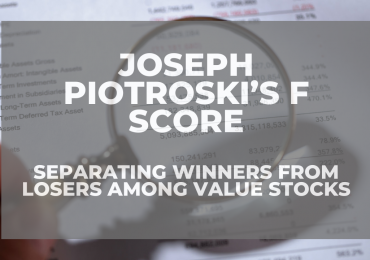Every other issue of The Validea Hot List newsletter examines in detail one of John Reese’s computerized Guru Strategies. This latest issue looks at the Joseph Piotroski-inspired strategy, which has averaged annual returns of 6.0% since its February 2004 inception vs. 1.8% for the S&P 500. Below is an excerpt from the newsletter, along with several top-scoring stock ideas from the Piotroski-based investment strategy.
Taken from the February 3, 2012 issue of The Validea Hot List
In 2000, however, Piotroski showed that you don’t need to be a smooth-talking Wall Street hotshot to make it big in the market. While teaching at the University of Chicago, he authored a research paper that showed how assessing stocks with simple accounting-based methods could produce excellent returns over the long haul. No fancy formulas, no insider knowledge — just a straightforward assessment of a company’s balance sheet.
His study turned quite a few heads on Wall Street. It focused on companies that had high book/market ratios — i.e. the type of unpopular stocks whose book values (total assets minus total liabilities) were high compared to the value investors ascribed to them (their share price multiplied by their number of shares). These are stocks that have very low expectations.
Quite often, such firms have low book/market ratios because they are in financial distress, and investors wisely stay away from them. On certain occasions, however, high book/market firms may be good companies that are being overlooked by investors for one reason or another. These firms can be great investment opportunities, because their stock prices will likely jump once Wall Street realizes it’s been shunning a winner.
Through his research, Piotroski developed a methodology to separate the solid but overlooked high book/market firms from high book/market ratio firms that were in financial distress. He found that this method, which included a number of balance-sheet-based criteria, increased the return of a high book/market investor’s portfolio by at least 7.5 percentage points annually. In addition, he found that buying the high book/market firms that passed his strategy and shorting those that didn’t would have produced an impressive 23% average annual return from 1976 and 1996.
Since I started tracking it in late February 2004, a 10-stock portfolio picked using my Piotroski-based model has outperformed the market handily, returning 6.0% annualized vs. 1.8% for the S&P 500. But it’s not for the faint of heart, as it can be very volatile — in fact, its beta of 1.37 is the highest of any of my 10-stock portfolios. It fared very well in 2004, 2005, and 2006, before struggling in 2007, 2008, and 2009. Then it roared back in 2010, gaining 55.9% — more than four times the S&P 500’s 12.8% gain. Last year, however, it was again hit hard, losing 24.4% while the broader market was flat. But so far in 2012 it has again bounced back strong, already gaining 17.8% vs. the S&P’s 5.3% gain. (All 2012 and since-inception figures through Feb. 1.) The big swings are likely a result of the strategy keying on smaller, beaten-down stocks at a time when investors have been prone to bouts of fear — primarily about macroeconomic issues. When those macro issues spark anxiety, investors dump smaller unloved stocks; then, when the fears subside, they dive back into the smaller value plays. So while you can make some nice profits over the long haul following a strategy like this, you have to have discipline — or else you’ll end up buying high, like after 2010, and selling low, like after 2011.
Let’s take a look at how Piotroski’s approach, and the model I base on it, work.
Diving into The Balance Sheet
Piotroski wasn’t the first to study high book/market stocks. But his research took things a step further than many past studies. He noted that the majority of high book/market stocks ended up being losers, and that the success of high book/market portfolios was usually dependent on the big gains of a small number of winners. Much as low price/earnings ratio investors like John Neff used a variety of tests to make sure low P/E stocks weren’t rightfully being overlooked because of poor financials, Piotroski sought to separate the high book/market winners from the high book/market losers.
The first step in this approach is, of course, to find high book/market ratio stocks. In his study, Piotroski focused on the stocks whose book/market ratios were in the top 20 percent of the market, so that’s the figure I use.
That’s the easy part. The harder part is determining whether investors are avoiding a low-B/M stock because it is in financial trouble, or whether the company is a solid one that is simply being overlooked. The Piotroski-based model looks at a variety of factors to determine this, including return on assets and cash flow from operations, both of which should be positive.
Piotroski also thought that good companies had cash from operations that was greater than net income. Such companies are making money because of their business — not because of accounting changes, lawsuits, or other one-time gains.
Several of Piotroski’ other financial criteria don’t necessarily look for fundamental excellence, but instead for improvement. This makes a lot of sense; a company whose return on assets had declined from 10 percent to 1 percent and whose cash flow from operations had dwindled from $10 million to $10,000 would pass the above ROA and cash flow tests, for example, but it certainly wouldn’t be the type of strong performer Piotroski was targeting. Looking at how a company’s fundamentals had been changing allowed him to not only get an idea of the firm’s financial position, but also of whether that position was improving or declining.
Among the other “change” criteria Piotroski examined were the long-term debt/assets ratio, which he wanted to be steady or declining; the current ratio (current assets/current liabilities), which he wanted to be steady or increasing; gross margin, which should be steady or rising; and asset turnover, which measures productivity by comparing how much sales a company is making in relation to the amount of assets it owns (That should be steady or increasing).
As you can see, the Piotroski-based approach is a stringent one. Here are the ten stocks currently in its 10-stock portfolio:
SkyWest, Inc. (SKYW)
Alpha Natural Resources (ANR)
HealthWays, Inc. (HWAY)
AU Optronics Corp. (AUO)
Digital Generation, Inc. (DGIT)
Legg Mason, Inc. (LM)
Brasil Telecom SA (BTM)
Ternium S.A. (TX)
ArcelorMittal (MT)
Invacare Corporation (IVC)
Think Small — And Boring
One final note on the Piotroski-based strategy: It usually ends up focusing on small stocks. Piotroski found that smaller high book/market firms were more likely to produce high returns than their larger counterparts, because small stocks are more likely to fly under the radar of analysts and investors. That means you are more likely to uncover winners using fundamental analysis of these smaller, less-followed stocks.
For the same reason, the stocks that my Piotroski-based model usually chooses tend to be from boring industries or make boring products, though it will go into more “interesting” areas when valuations are right (as it is right now, with a few tech stocks among its holdings). But while they’re not the flashiest firms, they’re quite often the type of stocks that can pay excellent returns over the long haul.






Comments are closed.